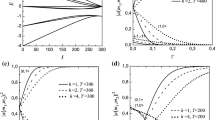Abstract
New set of maximally entangled states (Singh-Rajput MES), constituting orthonormal eigen bases, has been revisited and its superiority and suitability in pattern-association (Quantum Associative Memory, QuAM) have been demonstrated. Using these MES as memory states in the evolutionary process of pattern storage in a two-qubit system, it has been shown that the first two states of Singh-Rajput MES are useful for storing the pattern |11> and the last two of these MES are useful in storing the pattern |10> Recall operations of quantum associate memory (QuAM) have been conducted through evolutionary process in terms of unitary operators by separately choosing Singh-Rajput MES and Bell’s MES as memory states and it has been shown that Singh-Rajput MES as valid memory states for recalling the patterns in a two-qubit system are much more suitable than Bell’s MES.
Similar content being viewed by others
References
Feynman, R.P.: Int. Theor. Phys. 26(21), 467–488 (1982)
Tan, H.T., Zhang, W.M., Li, G.: Phys. Rev. A 83, 032102–108 (2011)
Grover, L.K.: . In: Proc. 28th Ann. ACM. Symp. On Theory of Computing, Philadelphia,. Pennsylvania, ACM Press, pp 212–221 (1996)
Simon, D.: SIAM Journ. Comp. 26(5), 1474–1483 (1997)
Shor, P.W.: . In: Proc. 35th Ann. Symp., Found of Computer Science, Los. Alamitos IEEE Comp. Press (1994) 20–22
Wang, Z.S., Wu, C., Feng, X.L., Kwek, L.C., Lai, C.H., Oh, C.H., Vedral, V.: Phys. Rev. A 76, 044303–307 (2007)
Wang, Z.S.: Phys. Rev. A 79, 024304–308 (2009)
Smirne, A., Breuer, H.P., Piilo, J., Vacchini, B.: Phys. Rev. A 84, 062114–119 (2010)
Benenti, G., Casati, G.: Phys. Rev. E 79, 025201R–205R (2009)
Hill, S., Wooters, W.K.: Phys. Rev. Lett. 78(26), 5022–5025 (1997)
Wooters, W.K.: Phys. Rev. Lett. 80(10), 2245–2248 (1998)
Rungta, P., Buzek, V., Caves, C.M., Hillery, M., Millburn, G.J.: Phys. Rev. A 64(4), 042315–320 (2001)
Coffman, V., Kundu, J., Wooters, W.K.: Phys. Rev. A 61(5), 052306 (2000)
Glaser, U., Buttner, H., Fehske, H.: Phys. Rev. A 68, 032318–326 (2003)
Ventura, D., Martinez, T.: Inf. Sci. 124, 273–296 (2000)
Grover, L.K.: Phys. Rev. Lett. 79, 4709 (1997)
Grover, L.K.: Phys. Rev. Lett. 80, 1329 (1998)
Ezkov, A., Nifanava, A., Ventura, D.: Inf. Sci. 128, 271–293 (2000)
Tchapet Njafa, J.P., Nara Engo, S.G., Woafo, Paul: Neural Network and Physical Systems with Emergent Collective Computational Abilities. Int. Journ. Theor. Phys. 52(6), 1787–1801 (2013)
Hopfield, J.J.: Proc. National Acad. Science, USA 79, 2554 (1982)
Singh, M.P., Rajput, B.S.: Int. Journ. Theor. Phys. 52, 4237–4255 (2013)
Singh, M.P., Rajput, B.S.: Euro. Phys. J. Plus 129(57), 1–13 (2014)
Singh, M. P., Rajput, B.S.: Int. Journ. Theor. Phys. 53(9), 3226–3238 (2014)
Singh, M.P., Rajput, B.S.: Int. Journ. Theor. Phys. 54(10), 3443 (2015)
Singh, M.P., Rajput, B.S.: Int. Journ. Theor. Phys. 55(7), 3207–3219 (2016)
Milman, P., Mosseri, R.: Phys. Rev. Lett. 90, 230403 (2003)
Ming, L.W., Tang, Z.L., Liao, C.J.: Phys. Rev. A 69, 064301–319 (2004)
Singh, M.P., Rajput, B.S.: Journ. Mod. Phys. 6, 1908–1920 (2015)
Hopfield, J.J.: Proc. National Acad. Science, USA 79, 2554 (1982)
Kosko, B.: JEEE Transactions on Systems 18, 49 (1988)
Pollack, J.B.: Artif. Intell. 46, 77 (1990)
Howell, J.C., Yeazell, J.A., Ventura, D.: Phys. Rev. A 62
Acknowledgments
Author Manu Pratap Singh thankfully acknowledges the financial support of University Grants Commission (UGC), New Delhi (India) in the form of a major research project: MRP-Major-Comp-2013-39460.
Author information
Authors and Affiliations
Corresponding author
Rights and permissions
About this article
Cite this article
Singh, M.P., Rajput, B.S. New Maximally Entangled States for Pattern-Association Through Evolutionary Processes in a Two-Qubit System. Int J Theor Phys 56, 1274–1285 (2017). https://doi.org/10.1007/s10773-016-3269-3
Received:
Accepted:
Published:
Issue Date:
DOI: https://doi.org/10.1007/s10773-016-3269-3



